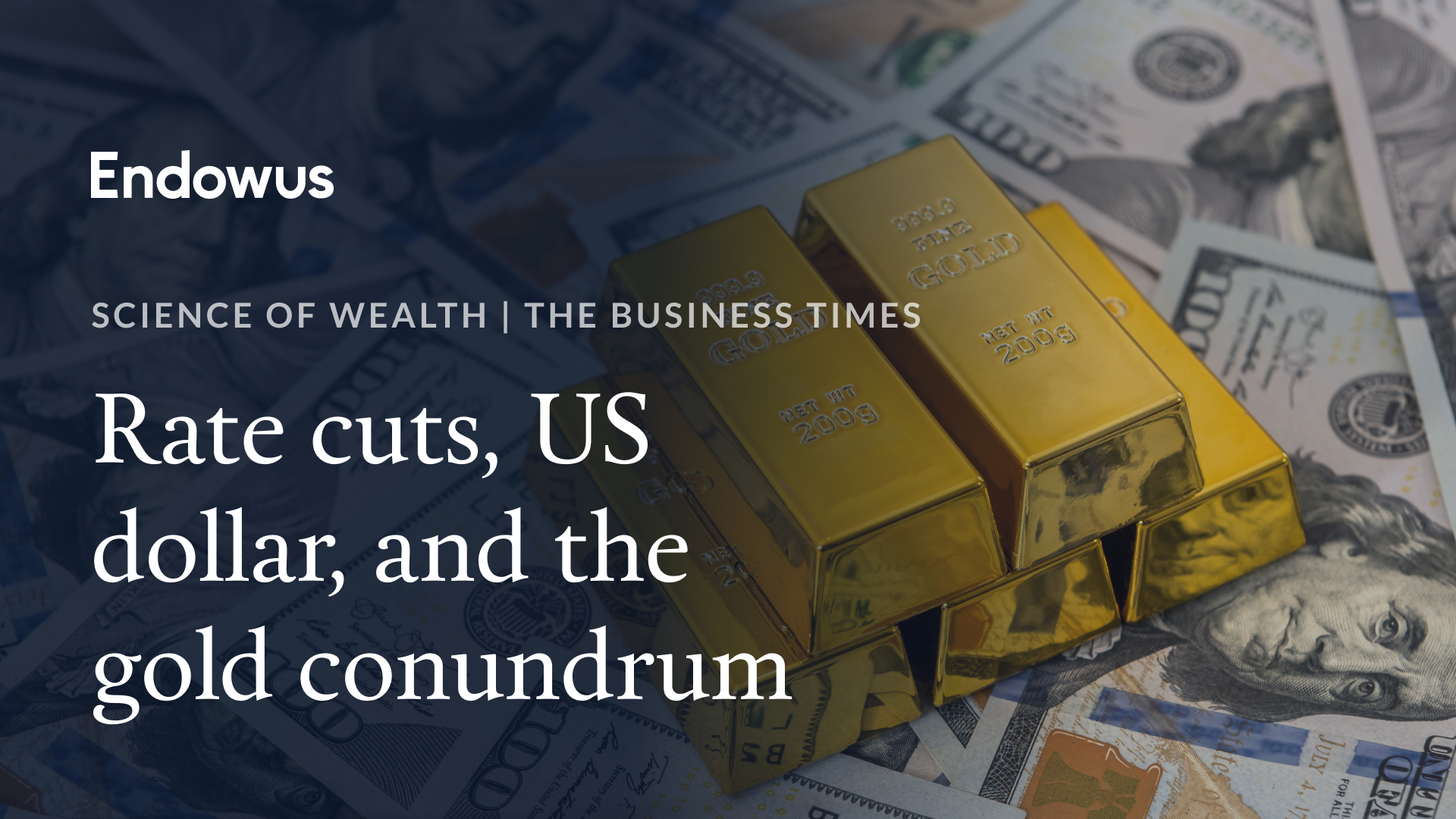Register for the event
Endowus invites you to our exclusive event with Macquarie Asset Management, as we discuss unlocking opportunities in Infrastructure- a $1.3tn asset class.
This event is reserved for Accredited Investors (AIs) only. To register for the event, please indicate one of the following:
The original version of this article first appeared in The Business Times.
The Fed cut rates as expected but all the action happened before. We have been seeing Treasury yields both on the short and long end continue to come down from July and so the latest cut was no surprise.
Despite the fact that interest rates fell, the US dollar has strengthened. And even though the US dollar has been stronger for several months now, both gold and other traditional risk-off assets, as well as all major risk asset prices have continued to go up. It is almost too good to be true.
As we know, the Fed has a dual mandate of keeping inflation at bay but also aiming for full employment. While inflation has abated, the uncertain outlook remains due to policy and geopolitical risk, and employment is seeing a strange phenomenon of both supply and demand declining at the same time. This is why the range of possible outcomes has increased and so has the uncertainty in predicting Fed rate policy.
In that context, it may be the right time for us to ask: Is it right to assume that we will see a continued trajectory of the economy, markets and asset prices, and interest rates from here?
The market moves ahead of the action
The market had already assumed this October cut and even a third cut in December was in the bag. The comments by Powell were aimed at tempering the market and preventing it from being complacent. As a result, the market probability of a rate cut in December dropped suddenly from above 90% to below 70%.
Having said that, the data is still suggesting a slowing economy, a looser employment market and a stable inflationary environment, which may allow the Fed to deliver a third and final rate cut for 2025 in December. Also, the Fed will end quantitative tightening (QT) then and will stop reducing the size of its securities portfolio and banking system reserves along with it.
A third cut would put the Fed rate at 3.5-3.75% heading into 2026, but the Fed is likely to remain data dependent and maintain a more neutral stance for as long as possible.
Will there be more rate cuts, and where will they lead us to?
The Fed could once again remain on hold after that to see how the labor market and inflation trend. However, there are two potential triggers that could change this.
The first is Fed Chair Powell’s term ending in May 2026. With the Trump administration certainly likely to push the FOMC towards a more dovish tilt, it could lead to renewed market optimism of a more aggressive rate cut and risk on scenario in 2026.
The second is less positive as a US recession or deterioration of labour markets, both of which are inherently disinflationary in nature, could allow the Fed to cut rates more proactively.
In the first scenario, all risk assets may continue to do well in 2026. However, in a recessionary scenario, equities tend to lag and treasuries and gold could do well. Not only does gold act as a natural hedge in a risk-off scenario, but it also benefits from the lower opportunity cost of holding the non-yielding asset as interest rates decrease.
However, gold has already done so well and it’s interesting that people talk about high valuations for equities, tech stocks, and yet no one talks about valuations of gold or bitcoin. It goes to show that valuations are an output, not an input, in investment decision-making.
What is driving gold, and is the rally related to the US dollar?
We know that price is a function of demand and supply. Gold is no different. There is a demand driven story for gold as central banks and individual buyers have stepped up on the gold trade with Chinese buying being a key factor.
Gold has been the best performing asset up 50% for the year. The next best performing are China equities, Japan equities and the Nasdaq with Bitcoin and other assets trailing far behind.
However, the sudden pullback of -10% in the past two weeks has certainly been a rude awakening. And if you are a Singapore dollar or non-US investor, then the returns are tempered even more as the weaker dollar dampens returns in local currencies.
Many have sighted various theories on why gold has done so well. Some say it’s because the US Fed has debased the currency by printing too many dollars. Others state that the fiscal situation is to blame. It has too much debt and the cost of servicing that debt is unsustainable.
However, if gold was truly a proxy for the anti-dollar debasement trade, it would have an inverse relationship with the US dollar. Gold has risen when the US dollar was weak and also recently when the US dollar was stronger. In fact, the US dollar stopped depreciating against a basket of global currencies since the summer and yet gold continued to rise due to the demand supply mismatch.
One argument suggests that the Chinese central bank has been buying gold not necessarily because of a negative view on the dollar or selling US assets, but rather, to shore up their reserves as a defensive—not offensive—move to protect the Renminbi against a future depreciation.
Should we be worried about US debt?

We also think that the continued noise about the US dollar debasement theory and concerns about its debt is misplaced.
While most people tend to focus on the absolute size of the debt, one should also look at the cost of borrowing, and the ability to service and eventually repay the debt. In this regard, the US actually is and remains a very reliable and trustworthy borrower. They have never defaulted on payments and the ability to service its debt is high.
Not only that, the total assets of the nation—the government, household, corporates, etc—or the collateral to back up that borrowing is still absolutely high and is 10 times as large as its borrowing.
Where do we go from now?
One of the most common questions we receive is about the weakness of the US dollar versus the Singapore dollar, and many investors are rushing to exit their US dollar position.
However, we all have a recency bias where we anchor our expectations against what has happened most recently. In fact, the US dollar has strengthened and the Singapore dollar has weakened since the middle of the year.
Like gold prices, short term price movements of currencies are driven by demand and supply mismatches. And when it comes to currencies, the interest rate differential is a critically important factor—despite Fed rate cuts, it still remains high at 3.75% to 4% compared to Singapore Overnight Rate Average, which stands at 1% to 1.45%.
The most dangerous four words in investing is “this time is different”. The longer you invest, you realise that history indeed rhymes but it doesn’t repeat itself. We need to overcome our recency bias and instead anchor our expectations on the longer term historical evidence.
Gold’s recent outperformance excepting, the commodity has returned an average return that falls behind the returns of equities which is a growth asset class. We know that gold can be a good store of value but it is not a yielding asset class. Thus there is no compounding nature to gold across economic cycles.
While it is perfectly fine to have an allocation to gold as a defensive store of value, we need to understand that it is a diversification tool and can also have extended periods of underperformance especially when your starting point is high.
Most importantly, one should refrain from chasing the latest hot asset class or country. A core allocation to equities and fixed income to diversify one’s portfolio that is appropriate to one’s risk appetite will help to generate stable and less volatile returns through the cycle. All that glitters is not gold.









.webp)




%20(1).gif)







%20F1(2).webp)

.webp)






.webp)